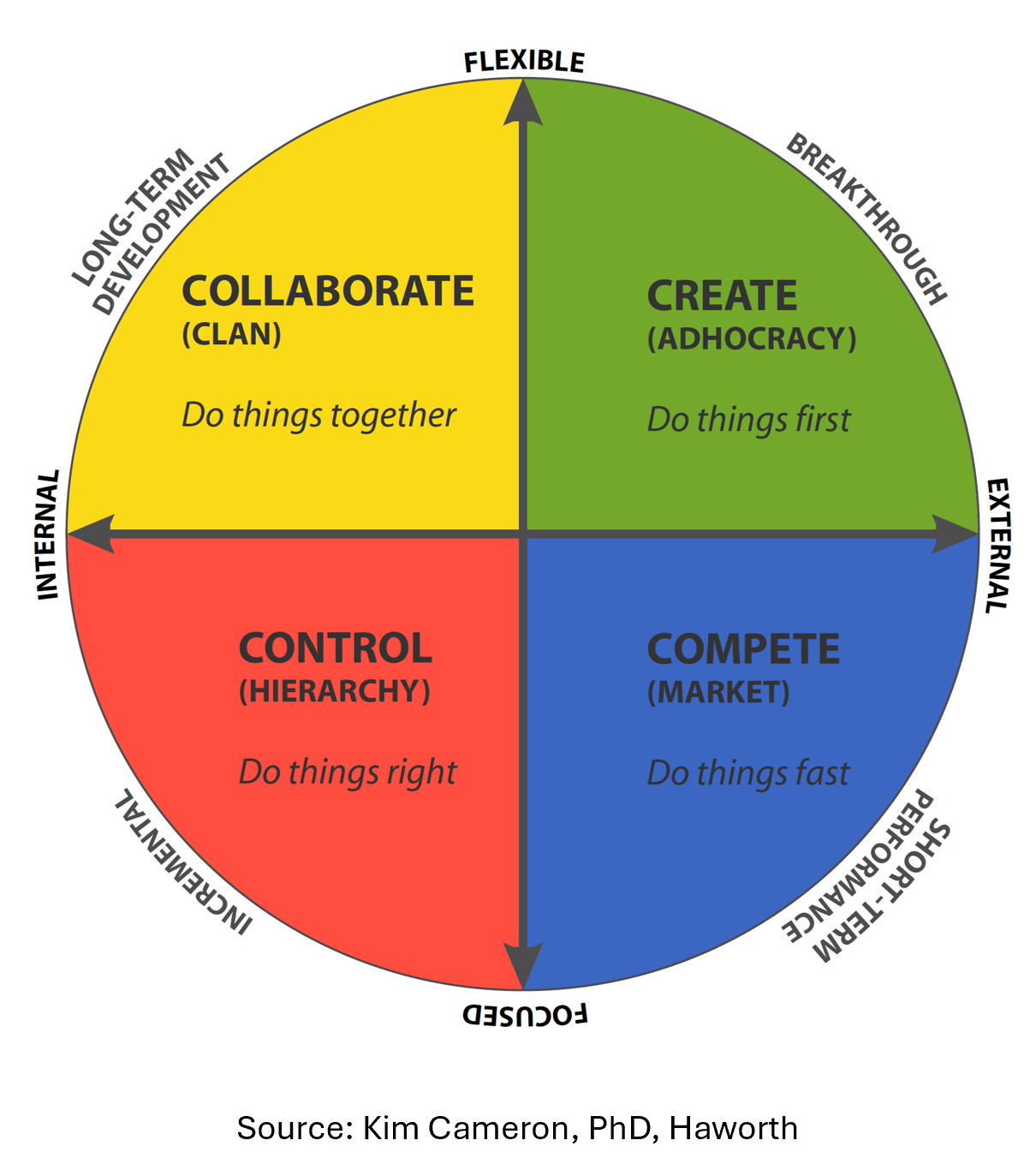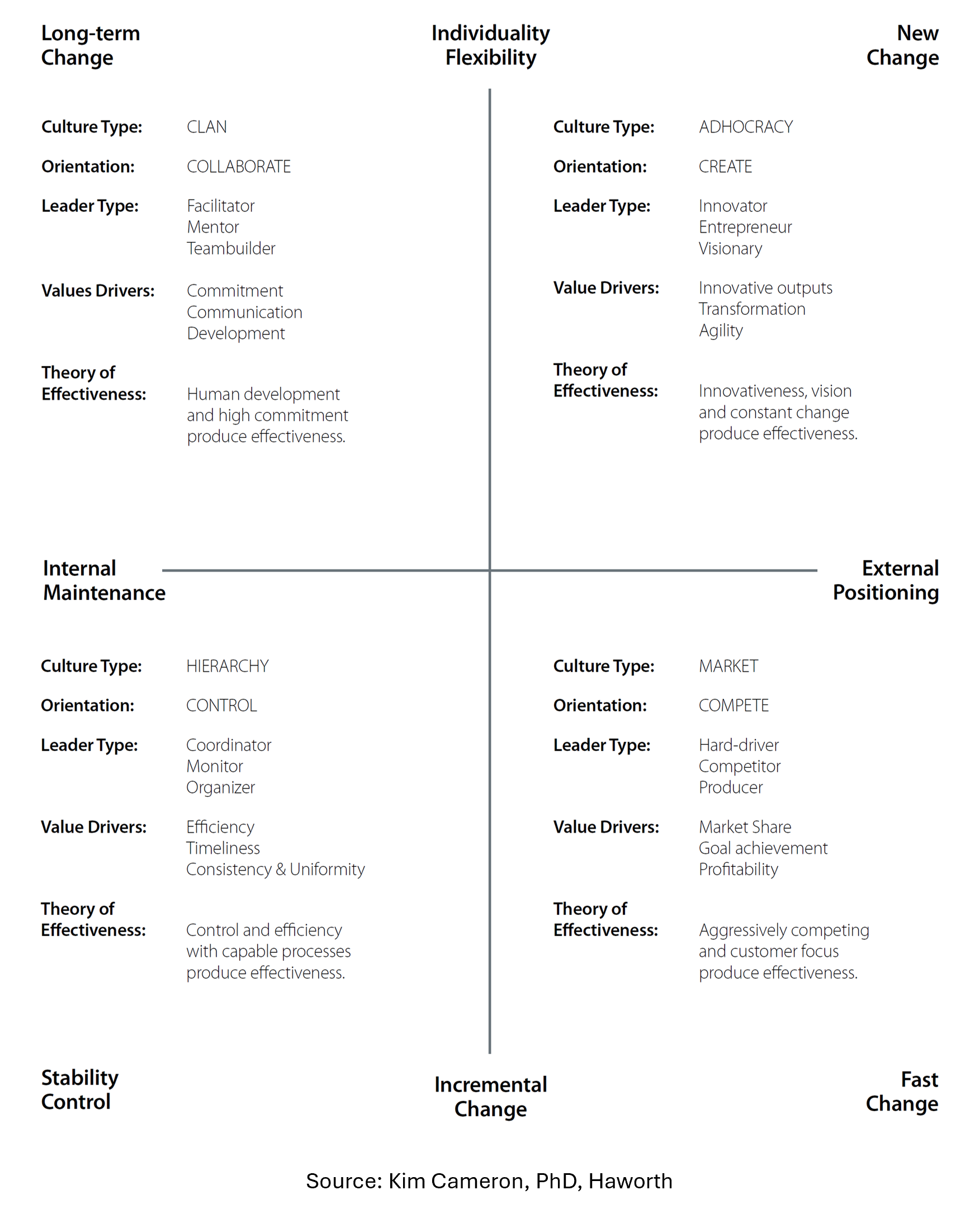Navigating Culture for Success: A Guide to the Competing Values Framework
The Competing Values Framework (CVF) is a widely recognised model for understanding organisational culture and improving organisational effectiveness. Developed out of the University of Michigan, the CVF provides a structured approach to analysing and balancing competing cultural dimensions within organisations. It enables leaders to recognise cultural strengths and weaknesses, identify areas for improvement, and build a balanced, adaptable culture that aligns with their strategic goals. By focusing on four distinct cultural types, the model helps organisations navigate the complexities of modern business environments where diverse values must coexist to foster innovation, performance, and sustainability.
The Competing Values Framework divides organisational culture into four quadrants: Clan, Adhocracy, Market, and Hierarchy. Each quadrant represents a distinct cultural type with its unique values, goals, and leadership styles. The framework recognises that while these types often coexist within an organisation, they can sometimes be in tension, requiring balance to achieve optimal performance.
- Clan Culture (Collaborative): This culture type emphasises internal focus, flexibility, and a family-like environment. It values teamwork, employee engagement, and cohesion, where leaders act as mentors or facilitators, fostering a sense of belonging and loyalty. Clan cultures prioritise collaboration and employee well-being, often resulting in high morale and low turnover.
- Adhocracy Culture (Creative): Focused on external positioning and adaptability, the adhocracy culture stresses innovation, agility, and risk-taking. Organisations with this culture encourage experimentation and a readiness to explore new ideas. Leaders in an adhocracy culture act as visionary entrepreneurs who inspire creativity and strive to remain at the cutting edge of their industry.
- Market Culture (Competitive): Market cultures prioritise external focus, stability, and control, where the primary goals are profitability, customer satisfaction, and market share. This culture is results-driven, often viewing competition as the pathway to success. Leaders in a market culture are goal-oriented, pushing for high performance and maintaining a competitive edge.
- Hierarchy Culture (Controlling): Characterised by internal focus and stability, hierarchy cultures focus on order, structure, and efficiency. Processes, procedures, and accountability are central, with leaders who function as organisers and coordinators, prioritising consistency and operational efficiency.
“Organisational leaders regularly confront issues such as how to be innovative, how to organise and deploy resources, and how to collectively grow and change as a system. Leaders must then determine how to confront these and other issues while recognising that “effectively” doing so within the scope of an organisational culture requires an awareness of the everyday tensions that exist within their organisations. Thus, these competing positive tensions comprise the Competing Values Framework.” – Jeff DeGraff
The framework positions the cultural types on two key dimensions: flexibility versus stability and internal versus external focus. Balancing these dimensions helps organisations maintain adaptability while achieving their performance goals.

Understanding organisational culture is crucial, as companies with a strong culture experience four times greater revenue growth, and teams aligned by a shared purpose and vision see a 17% performance boost (Harvard Business Review), underscoring the tangible benefits of fostering a cohesive and values-driven workplace.
Applying the Competing Values Framework begins with assessing the organisation’s current culture. The below steps provide a suggested method to implementing the CVF:
- Conduct a Cultural Assessment: Use surveys, interviews, and cultural diagnostic tools to determine which cultural types dominate the organisation. For example, employees may rate statements related to collaboration, innovation, competition, and structure to reveal preferences and perceptions.
- Identify Desired Cultural Balance: Based on the organisation’s goals and industry demands, determine the ideal cultural mix. If a company aims to become more innovative, shifting towards an adhocracy culture could help foster experimentation and agility.
- Implement Targeted Initiatives: Develop programs and policies that reinforce the desired cultural dimensions. For example, introducing team-building activities can support a clan culture, while implementing competitive performance incentives can strengthen a market culture.
“A key message of the CVF is that despite the different ways for defining organisational effectiveness, it is important that companies are appropriately aligned in their respective definition of effectiveness. Once aligned, companies can find their innovation sweet spot and achieve the growth outcomes that they desire.” – Jeff DeGraff
The CVF encourages leaders to embrace and balance competing values within their organisation, recognising that each cultural type has strengths that can be leveraged under specific circumstances.

The Competing Values Framework offers a comprehensive approach to building an effective and balanced culture. Its importance lies in several key areas:
- Enhancing Organisational Adaptability: The framework acknowledges that different situations call for different cultural approaches. For example, an innovative culture may be beneficial in a startup setting, while a more structured, hierarchical culture may be necessary in highly regulated industries. The CVF allows organisations to adapt dynamically to changing environments.
- Supporting Strategic Alignment: The CVF helps organisations align their culture with strategic priorities. If a company wants to improve customer satisfaction, fostering a market culture focused on competitiveness and performance may align better with that goal. Alternatively, to promote employee engagement, emphasising clan culture can create a supportive environment.
- Promoting a Balanced Organisational Identity: Organisations are complex and may benefit from multiple cultural types simultaneously. By understanding the interplay of these types, leaders can create a balanced identity that integrates diverse values, offering stability while allowing for innovation and growth.
- Improving Leadership and Decision-Making: The CVF provides a framework for leaders to reflect on their own leadership style and adapt it to fit organisational needs. Leaders can move fluidly between roles as mentors, innovators, managers, and competitors, depending on what the organisation requires.
The Competing Values Framework is a powerful tool for understanding and managing organisational culture. By identifying and balancing clan, adhocracy, market, and hierarchy cultures, organisations can foster an adaptable culture aligned with strategic objectives. The CVF’s emphasis on flexibility, adaptability, and balanced values helps organisations respond effectively to industry challenges and changing environments. Leaders who leverage this framework can make better informed decisions that align cultural strengths with strategic goals, that ultimately (and hopefully) create resilient and high-performing organisations.




